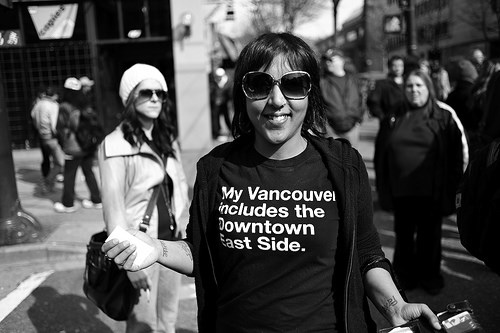The Downtown Eastside is Awesome.
Well, not as a whole. The neighbourhood is severely problematic, for all the reasons you've heard about time and time again, and they're the type of issues that will probably never go away. Life is a daily struggle in Vancouver's Downtown Eastside. For “Canada's poorest postal code”, the constant coverage of doom and gloom make the entire thing seem as bleak as an episode of The Wire.
But there are individual parts of the area that can be absolutely awesome. They happen when people rise above the hardships to express their humanity. They can be group organizations such as Insite or the Downtown Eastside Street Market that took it upon themselves to become even a small solution to a problem and made resident's lives better for it. They can be characters such as the condom fairy, who routinely walks the streets handing out protection dressed in, yup, a fairy costume, or Dino, the man with perhaps the biggest soul in the Eastside who will never shy to offer life advice. The human aspect is perhaps best represented by the 1999 National Film Board documentary Through A Blue Lens, that follows a handful of VPD officers navigating the rampant drug abuse to make personal connections with residents and enact positive change in their lives.
The thing is you would have to spend time in the Downtown Eastside to pick up on most of these qualities. The neighbourhood has a mystique amongst the rest of Vancouver that it is inherently dangerous and thus should be avoided. So we only hear about all the bad things, and have no idea about all the good. It's no Disneyland, or even Gastown, but you have a better chance of running into trouble on early morning Granville St then you would on Hastings during the day. These are still Vancouverites, just like you and I.
And this is where Vancouver started. At the turn of the century, Main and Hastings was the nucleus of the young city, home to Carnegie Public Library, city hall, and the Woodward's department store. It was a major railroad hub that attracted miners, loggers, and other labourers passing through the city, leading to the creation of the SRO hotels that now provide a majority of the low-income housing in the neighbourhood. Eventually, the epicentre of downtown Vancouver moved West towards its present-day location, and the neighbourhood began its long slide. The cultured aesthetic began to slip away, and the illicit behaviours favoured by the migrant labourers quickly filled the spaces left behind. When Woodward's went bankrupt in 1993, the area entered its darkest period.
The turn of the century entered two very important phrases into Vancouver's lexicon: harm reduction and the social mix. Insite recently celebrated its 10th year of operation, surviving challenges from the Federal Government to take a new approach to drug policy that has shown to save lives and money. It was also in 2003 that councillor Jim Green convinced city hall to purchase the old Woodward's building, setting the wheels in motion for the revitalized building that mixed social housing with market-rate housing.
But you know all of that already, and you probably heard something this summer about gentrification, but we're not here to get into those debates. We're here to see the trees for the forest and look at the individual aspects of one the most unique neighbourhoods in Canada. We're here to celebrate the positive and the change and the hope that you never glean from statistics or reports or think pieces. This is about inspiration and the human element, and I can't wait to share it with you.



